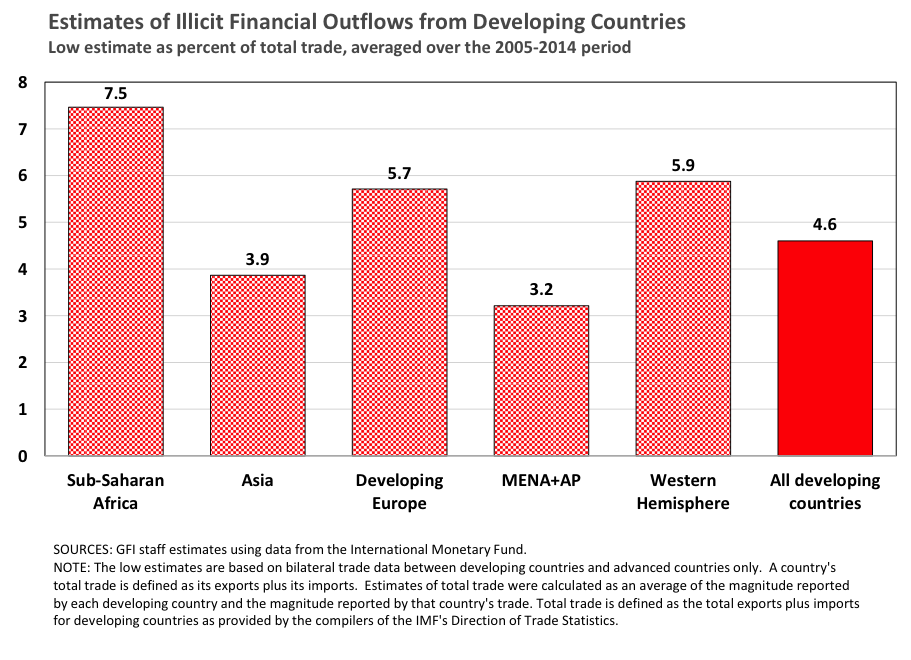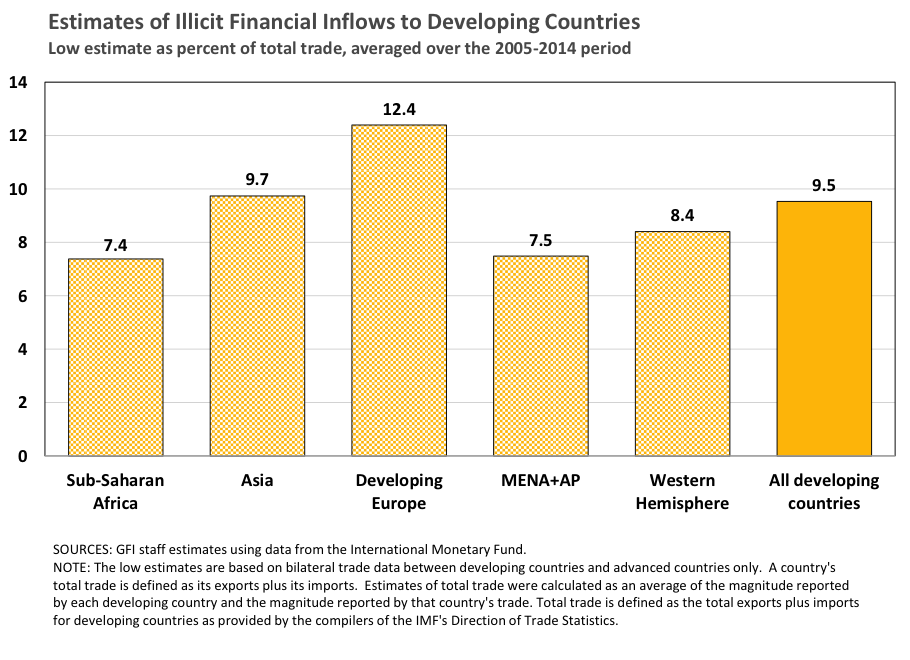May 1, 2017
Christine Clough, PMP
US$620 billion-970 billion drained from developing world in 2014, primarily through trade fraud
Illicit inflows similarly harmful and estimated at $1.4-$2.5 trillion in 2014
Combined, illicit outflows and inflows accounted for 14.1-24.0 percent of total developing country trade over 2005-2014
Sub-Saharan Africa Still Suffers Largest Illicit Outflows as percent of GDP
WASHINGTON, DC – Illicit financial flows (IFFs) from developing and emerging economies kept pace at nearly US$1 trillion in 2014, according to a study released today by Global Financial Integrity (GFI), a Washington, DC-based research and advisory organization. The report pegs illicit financial outflows at 4.2-6.6 percent of developing country total trade in 2014, the last year for which comprehensive data are available.
Titled “Illicit Financial Flows to and from Developing Countries: 2005-2014,” the report is the first global study at GFI to equally emphasize illicit outflows and inflows. Each is found to have remained persistently high over the period between 2005 and 2014. Combined, these outflows and inflows are estimated to account for between 14.1 and 24.0 percent of developing country trade, on average.
“The order of magnitude of these estimates, much more so than their exactitude, warrants serious attention in both the developing countries and the wealthier world,” said GFI President Raymond Baker, a longtime authority on financial opacity. “Years of experience with businesses and governments in the developing world have taught us that the decision to bring illicit flows into a particular developing country often marks only the first phase of a strategy to subsequently move funds out of the country. Together, illicit inflows and outflows sap the crucial financial resources needed to reach the Sustainable Development Goals.”
Additional Findings
- An average of 87 percent of illicit financial outflows over the 2005-2014 period were due to the fraudulent misinvoicing of trade.
- Illicit financial outflows from Sub-Saharan Africa ranged from 5.3 percent to 9.9 percent of total trade in 2014, a ratio higher than any other geographic region studied.
- Total illicit financial flows (outflows plus inflows) grew at an average rate of between 8.5 percent and 10.1 percent a year over the ten-year period.
- In 2014, outflows are estimated to have ranged between $620 billion and $970 billion, while inflows ranged between $1.4 trillion and $2.5 trillion.



Policy Recommendations
- Governments should establish public registries of verified beneficial ownership information on all legal entities, and all banks should know the true beneficial owner(s) of any account in their financial institution.
- Government authorities should adopt and fully implement all of the Financial Action Task Force’s (FATF) anti-money laundering recommendations; laws already in place should be strongly enforced.
- Policymakers should require multinational companies to publicly disclose their revenues, profits, losses, sales, taxes paid, subsidiaries, and staff levels on a country-by-country basis.
- All countries should actively participate in the worldwide movement towards the automatic exchange of tax information as endorsed by the OECD and the G20.
- To curtail trade misinvoicing:
- customs agencies should treat trade transactions involving a tax haven with the highest level of scrutiny;
- governments should significantly boost their customs enforcement by equipping and training officers to better detect intentional misinvoicing of trade transactions, particularly through access to real-time world market pricing information at a detailed commodity level; and,
- GFI has developed a product to assist governments in the detection of potential misinvoicing in real time—GFTrade™, a proprietary risk assessment application developed to enable customs officials to determine if goods are priced outside typical ranges for comparable products.
- Governments should sign on to the Addis Tax Initiative to further support efforts to curb IFFs as a key component of the development agenda.
Methodology
To conduct the study, GFI analyzed discrepancies in bilateral trade statistics and balance of payments data, as reported to the International Monetary Fund, in order to detect flows of capital that are illegally earned, transferred, and/or utilized. Since GFI’s last global report, released December 2015, the estimation methodology has been refined. These revisions generate a lower and upper bound for the estimates and account for several country idiosyncrasies.
To schedule an interview with Mr. Baker, Mr. Matthew Salomon, or Mr. Joseph Spanjers, contact Christine Clough at cclough@gfintegrity.org / +1 202 293 0740, ext. 231. On-camera spokespersons are available in Washington, DC.
###
Notes to Editors:
- Click here to download a fully copy of the report, to read the report online, and to download the report data.
- More information about GFTrade™ is available here.
- All monetary values are expressed in nominal U.S. dollars (USD). All percentage values are expressed as a percentage of a country’s (or country group’s) total trade (exports plus imports) with the world.

